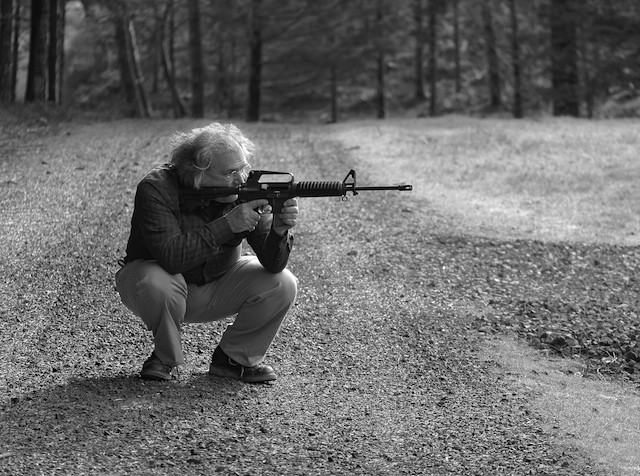Retrieving the rifle: an overlooked skill

If you haven’t taken my Perimeter Defense Rifle class (or read Protecting Your Homestead), you may not know that one of the things I teach is the idea that the rifle is the gun we are most unlikely to have on our person when we need it. It’s the firearm that needs to be retrieved in order to use, and that affects how we train and practice.
The popularity contest
It’s quite popular in rifle classes these days to shoot from a slung-in-front configuration — with the rifle hanging in the perfect position, hands pre-placed and, very often, with the buttstock already on the shoulder. This makes it fast and easy to simply swing the gun up and into a shooting position, decreasing the time it takes to fire a shot (and giving the guy holding the shot timer some reason for existing.)
Despite the ubiquity of the practice, I consider it so unrealistic as to be laughable, because it assumes you already have the gun with you, and slung just so, when the problem starts!
In reality, when an incident occurs for which you need the rifle it’s very unlikely that you’ll be “on patrol”, with the gun conveniently slung where you can simply raise it and shoot. You’re not going to be on a SWAT entry team with the butt of your rifle already planted on your shoulder.
The more likely scenario is that you’ll suddenly become aware that you need a rifle. You’ll run to the rifle’s storage place, grab it (and a magazine, if necessary), get the gun into a condition to be used, make your way to the point where you can/will employ it, then (if necessary) shoulder it and make the shot.
That’s a very different set of skills.
Sling, slung, slang?
Because of the need to respond to a developing situation, and the urgency it causes in one’s reactions, I don’t believe most people will actually take the time to get “slung up” or don one of those chest harness/magazine carrier contraptions.
I’ve used a rifle as a defensive tool, and in none of my incidents did I even think about using the sling. (I’ll admit to not owning any of those chest harnesses, but I’m quite sure I would also have left it behind in my rush to get the rifle into play.)
This is quite consistent with what people I’ve interviewed have told me about their defensive experience with the rifle. As one said: “When someone is shooting at you, everything that’s non-essential goes right out the window.”
The sling, in my opinion, is usually non-essential to the job of putting rounds downrange. Someone once said that the sling is to the rifle what the holster is to the pistol, but I think even that analogy implies more importance than it should. Practicing from a slung position, I believe, is a waste of valuable resources because plausible incidents don’t often happen that way.
I think it’s far more valuable to practice a realistic skill set, those things that you’ll actually need to do when it’s time for the rifle.
What might that look like?
Grab and go
Since the rifle is the arm that you need to go and get, it seems to me that learning how to retrieve and move with it is important. Like drawing the handgun, retrieving the rifle is a skill that must be practiced. Oddly, though, it’s one that gets little to no attention in most rifle curriculums. See the disconnect?
Being able to get to the storage area quickly, access the rifle, easily get it out of the storage device, and move rapidly and safely to the point where it will be employed are all tasks that need to be practiced if they’re to be done efficiently. This is the time for “grab the gun and go”, not “get geared up to be all tactical and stuff”.
Think about your rifle and how you train with it. When was the last time you factored any realistic skills into your practice routine? I submit that you’ll gain far more from paying attention to those than adjusting a sling to reduce your shot time by a tenth of a second.
-=[ Grant ]=-
P.S.: My Threat-Centered Revolver course in Phoenix, AZ this November is filling up! This will be my last open-enrollment course of 2019, so if you’ve been putting off registration don’t wait any longer. You can learn more (and sign up) at this link.
Listen to this blog – and subscribe to it on iTunes by clicking this link!- Posted by Grant Cunningham
- On August 23, 2019

